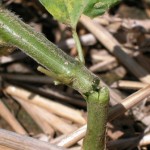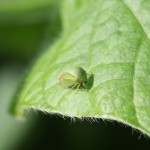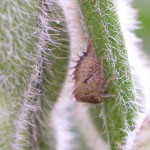Threecornered alfalfa hoppers (TCAH) are being reported in soybean fields scattered throughout West Tennessee. In my experience, populations during the seedling stage are often highest in late planted, reduced tillage fields (often in wheat beans). In soybean less than 8-10 inches tall, this insect feeds in a circular fashion around the plant stem with its beak. This girdling will eventually cause a swollen callus on the stem, but this may not be obvious on small plants. Girdling causes little damage unless plants break over. Plants often lodge later in the season during a high wind, especially if plants are loaded with pods. Lodging tends to be worse where plant stands are thin. Seed treatments such as Cruiser and Gaucho provide some early-season protection, but they may not be enough in small fields where hoppers are moving in from the edges. Later in the season, they girdle higher in the plant canopy (on leaf petioles and the stems of floral racemes).
Once you get familiar with threecornered alfalfa hoppers, it is fairly easy to identify (see pictures below). The adults are wedge-shaped, slightly less than ¼-inch long, and are green in color. Adult males will have a little red color. Immatures are similar in shape but have a row of spines down the center of their back. They may be green or brown in color. As their name implies, they hop readily.
The treatment threshold is when 10% or more of plants less than 8-10 inches tall have signs of girdling. Acephate/Orthene at 0.75 lb/acre (90S formulation) and the labeled synthetic pyrethroids should provide good control. One trick is to use your sweep net handle to bend plants over. Those plants that pop/break cleanly are usually those that have been girdled. You may notice plants breaking as you walk through the field. There is no treatment threshold based on numbers of threecornered alfalfa hoppers during the early season. However, you can use a sweep net on surprising small beans to get a sense of population levels. Catching 20 or more per 100 sweeps should trigger a closer look for girdling. Catching 50 or more would be cause for concern, and treatment should be considered. Once plants are 10 inches in height or taller, treatment is not normally recommended unless populations exceed one per sweep (100 per 100 sweeps).





One thought on “Watch for Threecornered Alfalfa Hoppers in Soybean”
Comments are closed.